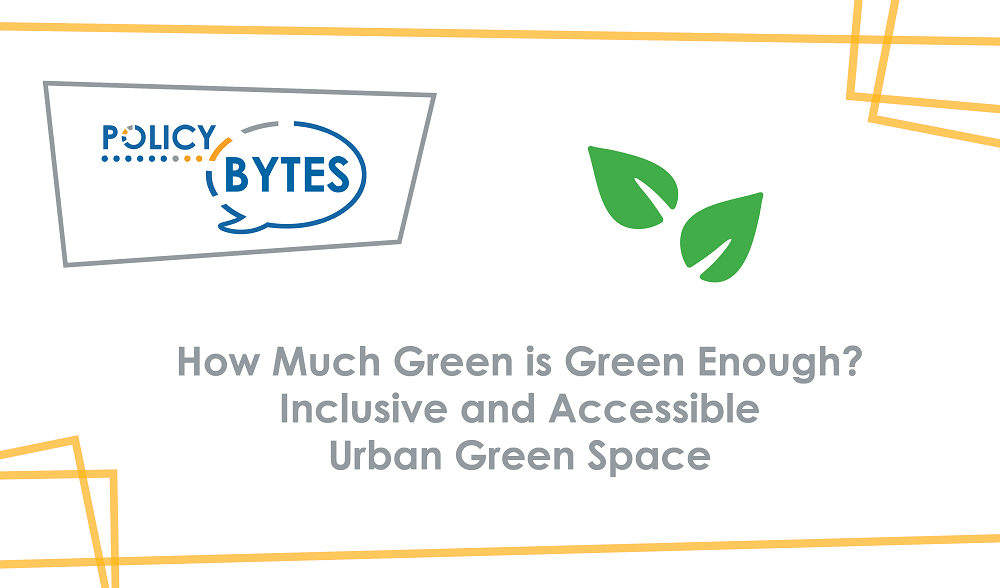How Much Green is Green Enough? Inclusive and Accessible Urban Green Space
December 10, 2018 - How important are parks? How much green is green enough for our health? Are parks and green space interchangeable terms? And how do we determine how much access to “green space” a community needs?

According to the World Health Organization (WHO), there are three categories of green space: small (trees and roadside vegetation), private (green roofs, private land) and large green space provided for social and recreational functions. The third category includes public parks.
Evidence shows that the most promising urban green-interventions, which are defined as “changes that significantly modify green space characteristics, use and functions” – are park-based interventions combined with social promotion activities. Park-based interventions involve a change to the built environment while combining social promotion activities that emphasize the quality of “green space”, neighborhood life and strengthen communities by building social capital.
It is bonding and bridging social capital that enhance networks and emerge over time into a small-scale, every day public life with the eventual trust and social control necessary for the self-governance of urban neighborhoods; comprised by a web of relationships and cooperative action.
Similarly, another study found that the quality and function of green space as well as their geographic determinants in terms of access are of higher importance than green space surface per capita; the latter often used by decision makers and public health promoters in planning. It is also well documented that people who are living closer in proximity to green space are more likely to use it; as green space provides mental health benefits, social interaction, and has a “direct relationship with the quality of life of urban dwellers”.
Evergreen’s Green Spaces: Forgotten Areas with High Potential report indicates that to make “cities inclusive, safe, resilient and sustainable” (Goal 11 of the United Nation’s 2030 Sustainable Development Goals), green spaces must be integrated into the planning of subdivisions and considered in enhancing downtown cores, coupled with sustainable development plans.
Designing eco-cities requires urban development that incorporates inclusivity and integrates local culture to promote civic participation, equal access, community participation and economic development; aspects integral to sustainability and enhancing standards of living.
Given this, how do we measure, evaluate and account for differing preferences in designing walkability, accessibility and path networks for green space? Furthermore, how do we account for structural factors such as systemic and institutional barriers? These barriers can include housing discrimination, limited access to health care, over policing or food insecurity in urban design and planning.
According to WHO, indicators can be as broad as “quality of life” or local investigations to support policy measure targets. Another avenue is replicating the Performance Standards Thunder Bay has included in their Urban Design and Landscape Guidelines report. A fourth option is using proximity-based indicators of green space accessibility, supplemented with data such as population density, points of access and indicators based on NDVI (Normalized Difference Vegetation Index), with mean value to indicate average “greenness” at city scale. More so, cities can undergo place making initiatives or conduct needs assessment surveys. For example, the Greater Sudbury Age Friendly Community Survey, responds to the needs of an aging population including having accessible and age-friendly public and outdoor spaces.
Of course, these solutions may not be what we originally expect upon closer investigation and listening to the needs of communities. They may be more strategic or nuanced. Perhaps instead of a new park, a small scale urban garden or pocket parks should be considered. Or, planting trees in areas of high noise pollution or where shade is necessary.
In Sudbury, the grassy area of Delki Dozzi Park has been created into the city’s first community food forest. Designed to mimic natural forest, the community tends to carefully planned edible perennial plants until it is self-sustaining. The pilot project by Sudbury Shared Harvest and reThink Green is currently in its second planting phase to consider food close to home, including planting and engaging community in educational workshops and food sharing.
With an estimated 70 per cent of the world’s population living in urban areas by 2050, integrating key economic, environmental and social policy insights into the designing of spaces is important. When designing urban spaces, keeping an asset based approach in mind is important, because well-planned green spaces link together residential, commercial and leisure aspects of a community
Keeping an asset based approach in mind, by designing green spaces that emphasize public right of access; community spaces can be multi-purpose, unique and emphasize inclusivity and accessibility as key indicators. They can also address issues such as food security and enhance the wellbeing, social belonging and life force of a neighbourhood.
Caitlin McAuliffe was an Experience North student summer placement with NPI for the summer of 2018.
The content of Northern Policy Institute’s blog is for general information and use. The views expressed in this blog are those of the author and do not necessarily reflect the opinions of Northern Policy Institute, its Board of Directors or its supporters. The authors take full responsibility for the accuracy and completeness of their respective blog posts. Northern Policy Institute will not be liable for any errors or omissions in this information, nor will Northern Policy Institute be liable for any detriment caused from the display or use of this information. Any links to other websites do not imply endorsement, nor is Northern Policy Institute responsible for the content of the linked websites.
Northern Policy Institute welcomes your feedback and comments. Please keep comments to under 500 words. Any submission that uses profane, derogatory, hateful, or threatening language will not be posted. Please keep your comments on topic and relevant to the subject matter presented in the blog. If you are presenting a rebuttal or counter-argument, please provide your evidence and sources. Northern Policy Institute reserves the right to deny any comments or feedback submitted to www.northernpolicy.ca that do not adhere to these guidelines.
